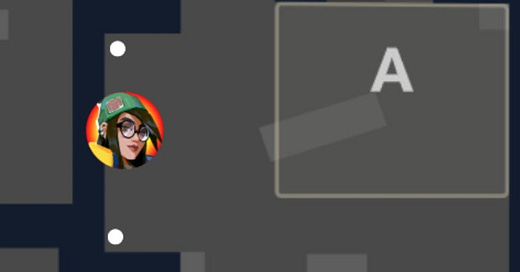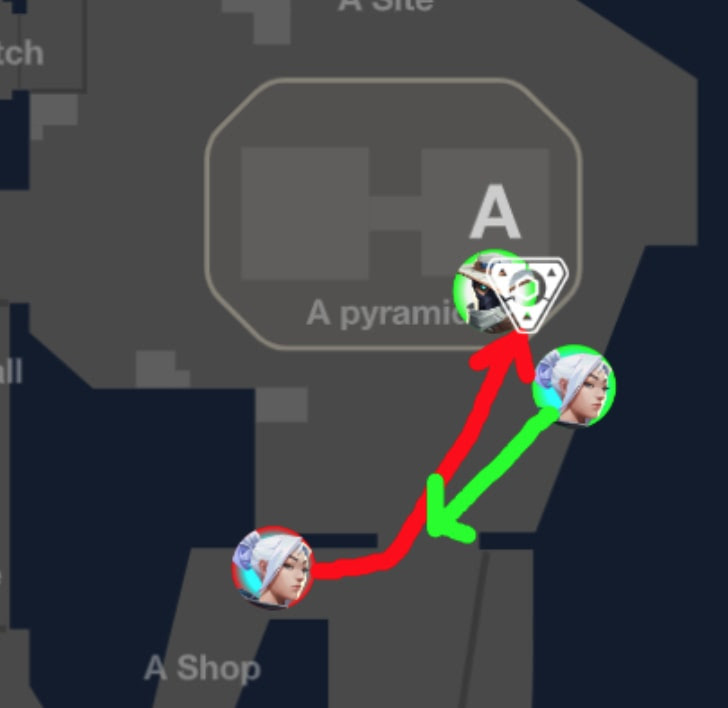Today’s post covers off-angles, a concept some of you will be familiar with. This, like much of my other writing, is meant to be a beginner-friendly introduction to a concept typically seen at higher levels of play. I’ve been blown away by the growth of this newsletter and deeply appreciate that you take the time to read my (hopefully coherent) ramblings. I have a number of articles in the works, but if there’s anything I haven’t yet covered that you would like me to write about, feel free to reach out!
An off-angle is a strange concept to articulate. Off-angles exist in relation to commonly held angles. On any map, any position from which another position can be held is an angle. A subset of these angles provide various advantages, including cover, ease of rotation, perspective advantage (the ability to see the other player before they can see you), etc. Over time, these positions become common. The more time you spend on each map, the greater your understanding of common spots (and angles). This understanding is the basis of good crosshair placement (pre-aiming), minimizing the amount of adjustment necessary to aim at an enemy. When you watch a good player clear an area, you will notice that their crosshair seems to be moving a split second more quickly than they are. Areas where opponents are likely to be are aimed at before they are visible, reducing the amount of time that the player must spend moving their crosshair to their target before shooting.
Off-angles are beneficial because of this (good) habit. An off-angle is an angle adjacent to or between commonly held angles. A successful implementation of this concept results in catching an enemy while they’re clearing a common angle, transitioning from one area to another, or setting up a piece of utility. Positioning yourself to take an off-angle has a number of benefits, though it is not without significant drawbacks. To illustrate these more clearly, let’s use A site Haven as an example.
In this scenario, Omen is pushing through A connector and Killjoy has chosen to hold an off-angle (the dots are some common positions from which A connector can be held, which Omen is likely to clear as he retakes site). Assuming Omen is an experienced player, he is likely to pre-aim each of these spots as he swings out, clearing each in succession. By positioning herself between two of these common spots, Killjoy is making sure that her first interaction with Omen will not involve getting swung on with his crosshair on her forehead. At worst, Omen will swing out and have to readjust his crosshair to hit her. At best, she will catch Omen walking, unaware of her positioning.
Off-angles are good precisely because they are theoretically sub-optimal. These positions are often without good cover, a place to fall back to, etc. In our example, the Killjoy is vulnerable to any player pushing any other lane. For this position to be relatively safe, heaven must either be smoked off or occupied by a teammate, and she must know that no flank is possible from long or short. If those criteria are met, and her only responsibility is to cover connector, this spot becomes useful. The off-angle’s theoretical downsides are what make them advantageous to use. Why would you stand in the open when you could stand next to cover? Because the extra milliseconds of time it takes for the other player to adjust to your unorthodox position is often enough to net you a kill.
These positions are often one-and-done spots, best used in 1v1 engagements. If more than one enemy pushes you it is highly likely that you will be traded given the relative lack of cover and/or rotational opportunity. This might be ok, especially if at a gun disadvantage where a one-for-one trade is slightly favorable, but escaping with your life is always the best outcome. Use these angles sparingly, as competent enemies will quickly catch on to your avant-garde playstyle.
I find this concept useful in thinking about how to position oneself when covering a defusing teammate, especially when the enemy’s location is known. By positioning yourself on an off-angle between the lane the enemy must push and your teammate defusing the spike, you will take contact before your teammate is seen and will often catch your opponent with their crosshair positioned toward your defusing teammate rather than you. In the example below, Jett’s positioning allows her to take contact prior to Cypher being visible to the enemy Jett.




